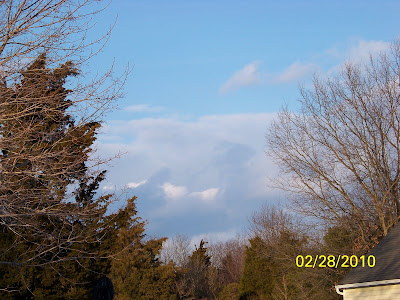
Did you know there is a point where it can’t get any colder and still be raining (because if it was any colder, it would be snowing)? Because we experienced that point, along with a brisk wind, all day on the 3rd.
Despite the winter cold, I have noticed a definite change to the feel and texture of the sunlight since the first of the month. It seems stronger and more golden. This could be attributable to atmospheric conditions or to the approaching spring season. As the summer solstice approaches, the earth’s natural tilt gradually swings us closer to the sun for a longer time each day.
 Image credit: Wilkapedia.org
Image credit: Wilkapedia.orgThe seasonal changes in North America take place due to this inclination of the earth. “As a consequence, for half the year (from around 20 March to 22 September) the northern hemisphere is inclined toward the Sun, with the maximum around 21 June, while for the other half year the southern hemisphere has this distinction, with the maximum around 21 December. The two moments when the inclination of Earth's rotational axis has maximum effect are the solstices (Wilkapedia, 2010).” Thus, by the time June 22nd rolls around, NJ will enjoy that hot summer sunlight.

This got me thinking about that other, less natural change to our daily time in the sunlight that is coming up: Daylight Saving Time. I know, I thought it was daylight savings time too. Like the daylight was being saved up over the winter and then slowly released over the warmer months. Most of the United States begins Daylight Saving Time at 2:00 a.m. on the second Sunday in March and reverts to standard time on the first Sunday in November. The change over time of 2 a.m. was selected to minimize disruption (DST, 2008). Evidently most people are home, asleep at 2 a.m., and a minimal number of trains are running.

Photo credit: Aengus Habersaat, 1/23/10 7:23am, Iona Island, Bear Mountain, NY
Despite the early hour for the actual change over, I always feel pretty disrupted for several weeks after the change. I get tired, cranky and never seem to get a decent night’s sleep. Last year I purchased a sunrise/sunset simulation lamp which produces a pleasant glow, but I’m still not looking forward to the shift. And what about the whole new start and end date for us to spring ahead and fall back? I could have sworn this made the adjustment even harder. According to the webpage “Daylight Saving Time” by Webexhibits through 2006, Daylight Saving Time in the U.S. ended a few days before Halloween (October 31). A new law to extend DST to the first Sunday in November took effect in 2007, with the purpose of providing trick-or-treaters more light and therefore more safety from traffic accidents. Anecdotally, the 2007 switch may not have had much effect, as it appeared that children simply waited until dark to go trick-or-treating (DST, 2008).

Is this correct? It sounds a bit whimsical. Specifically, I doubt the US government would do anything to help a holiday most folks feel the candy companies are perpetuating. Don’t believe everything you read on the web!
Elsewhere I found articles stating that the main purpose of the earlier shift was to reduce energy consumption by light bulbs. Also, grade school teachers love to credit Benjamin Franklin with the invention of daylight saving time. It appears Ben did suggest waking earlier to take full advantage of each hour of sunshine in a satire he wrote in 1784. However, I found a Wilkapedia article attributing the modern practice to George Vernon Hudson, a New Zealand entomologist, in 1895 (Wilkapedia, 2010).
Daylight Saving Time, like all environmental issues, remains a controversial matter with staunch supporters for and against it. While I have my sleep deprivation problems, I can’t complain over the longer hours of sunshine. I am hoping extra exercise and regular hikes to take blog photos will help me with the change this year. Now that the snow has melted in most areas, and the weather report promises sunshine, I am ready to get in a few good hikes. See you on the trail!



